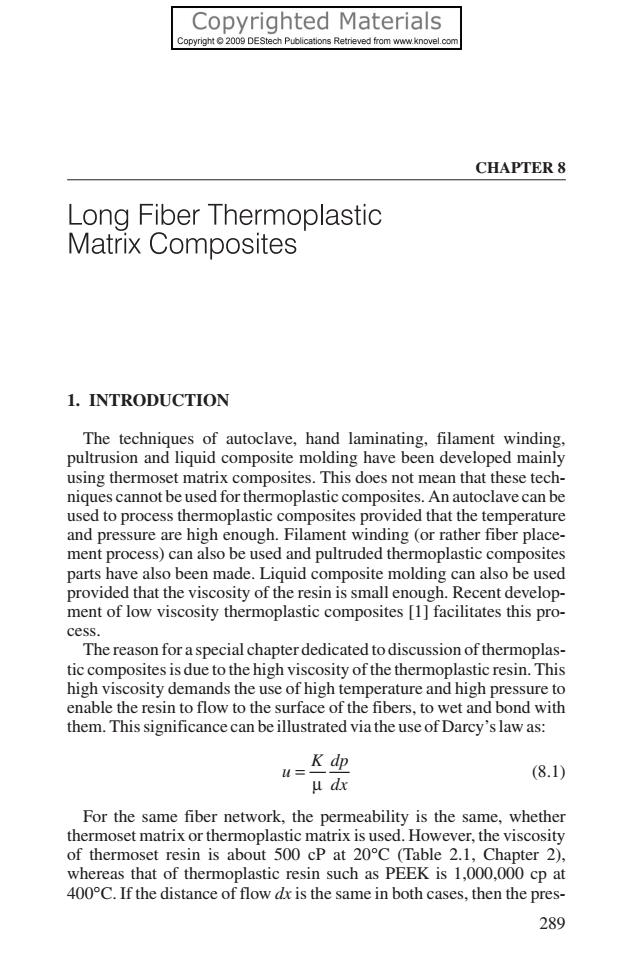正在加载图片...

Copyrighted Materials Copyright 2009 DEStech Publications Retrieved from www.knovel.com CHAPTER 8 Long Fiber Thermoplastic Matrix Composites 1. INTRODUCTION The techniques of autoclave, hand laminating, filament winding, pultrusion and liquid composite molding have been developed mainly using thermoset matrix composites. This does not mean that these tech- niques cannot be used for thermoplastic composites. An autoclave can be used to process thermoplastic composites provided that the temperature and pressure are high enough. Filament winding (or rather fiber place- ment process) can also be used and pultruded thermoplastic composites parts have also been made. Liquid composite molding can also be used provided that the viscosity of the resin is small enough. Recent develop- ment of low viscosity thermoplastic composites [1] facilitates this pro- cess. The reason for a special chapter dedicated to discussion of thermoplas- tic composites is due to the high viscosity of the thermoplastic resin. This high viscosity demands the use of high temperature and high pressure to enable the resin to flow to the surface of the fibers, to wet and bond with them. This significance can be illustrated via the use of Darcy's law as: K dp (8.1) u dx For the same fiber network, the permeability is the same, whether thermoset matrix or thermoplastic matrix is used. However, the viscosity of thermoset resin is about 500 cP at 20C (Table 2.1, Chapter 2), whereas that of thermoplastic resin such as PEEK is 1,000,000 cp at 400C. If the distance of flow dx is the same in both cases, then the pres- 289CHAPTER 8 1. INTRODUCTION The techniques of autoclave, hand laminating, filament winding, pultrusion and liquid composite molding have been developed mainly using thermoset matrix composites. This does not mean that these techniques cannot be used for thermoplastic composites. An autoclave can be used to process thermoplastic composites provided that the temperature and pressure are high enough. Filament winding (or rather fiber placement process) can also be used and pultruded thermoplastic composites parts have also been made. Liquid composite molding can also be used provided that the viscosity of the resin is small enough. Recent development of low viscosity thermoplastic composites [1] facilitates this process. The reason for a special chapter dedicated to discussion of thermoplastic composites is due to the high viscosity of the thermoplastic resin. This high viscosity demands the use of high temperature and high pressure to enable the resin to flow to the surface of the fibers, to wet and bond with them. This significance can be illustrated via the use of Darcy’s law as: u K dp dx = µ (8.1) For the same fiber network, the permeability is the same, whether thermoset matrix or thermoplastic matrix is used. However, the viscosity of thermoset resin is about 500 cP at 20°C (Table 2.1, Chapter 2), whereas that of thermoplastic resin such as PEEK is 1,000,000 cp at 400°C. If the distance of flow dx is the same in both cases, then the pres- 289